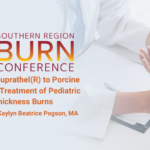Abstract | December 20, 2021
Comparison of Suprathel(R) to Porcine Xenograft in the Treatment of Pediatric Partial Thickness Burns
Learning Objectives
- Discuss how Suprathel(R) appears to be viable alternative to porcine xenograft in the treatment of pediatric partial thickness burns.
- Describe that length of stay and hospital cost of the two skin substitutes are comparable.
Introduction:
In August of 2020, our institution transitioned from porcine xenograft to Suprathel(R) for the management of pediatric partial thickness burns. This change in treatment was the due to the discontinuation of porcine xenograft by the main US supplier. We sought to make a cost and length of stay analysis of Suprathel(R) as compared to porcine xenograft on pediatric burns.
Methods:
Patients were identified using an institutional Burn Center registry and linked to clinical and administrative data. All pediatric patients admitted between January 1st, 2019 to March 31st, 2021 who sustained partial thickness burns were eligible for inclusion. Length of stay, total burn surface area (TBSA), hospital cost, and burn etiology were evaluated.
Results:
A total of 259 patients were identified, 47 of whom received Suprathel(R) and 212 of whom received xenograft. Average age for Suprathel(R) patients was 5.4 with 51.1% male, average age for xenograft patients was 4.6 with 58.5% male. Etiology of burns was 83.0% scald and 10.6% flame for Suprathel(R) patients and 80.2% scald and 9.0% flame for xenograft patients. Suprathel(R) patients had an average TBSA of 5.3% and xenograft patients an average TBSA of 4.3%. Average length of stay for Suprathel(R) patients was 3.4 days and 3.2 days for xenograft patients. Suprathel(R) patients had an average hospital cost of $28,415 and xenograft patients an average of $27,935.
Conclusions:
Suprathel(R) and porcine xenograft have comparable cost and hospital length of stay profiles for the treatment of pediatric partial thickness burns. Similar burn etiology and %TBSA was also noted. More analysis is needed with wound healing indices and safety profiles to determine non-inferiority.

